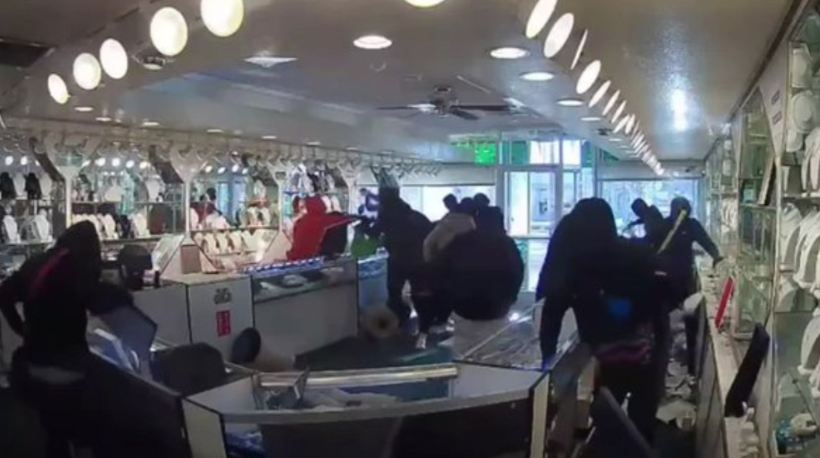By Prashant Shah
A chilling wave of smash-and-grab robberies has swept across California, specifically targeting Indian-owned jewelry stores. What began as sporadic incidents has escalated into a deeply troubling trend that is shaking communities, traumatizing store owners, and straining law enforcement resources. As the festive season approaches, what should be a time of joy and celebration for these family-run businesses has turned into a period of fear and uncertainty. Customers now hesitate to visit their trusted jewelers, while store employees live with the daily anxiety of not knowing when the next attack will occur.
The recent string of incidents paints a grim picture. On July 18, robbers attempted to break into Nijjar Jewelers on East El Camino Real in Sunnyvale—just a stone’s throw from two other stores hit earlier this year. This followed a shocking robbery on July 1 at Amber Jewelers and Watch Palace in Artesia. That day, just before 6 p.m., at least a dozen masked assailants stormed the shop, shattering display cases and stealing gold and diamond jewelry in a frenzied attack. Surveillance footage revealed scenes of chaos: terrified employees taking cover, glass shards flying, and the suspects fleeing in multiple vehicles. Witnesses suggested that up to 30 people may have been involved, marking it as one of the most brazen heists to date.
Just days earlier, on June 29, Manisha Jewelers in Sunnyvale experienced a similarly violent attack. A stolen vehicle was rammed through the storefront, and within 90 seconds, robbers armed with hammers had looted countless items from the shattered cases. Video footage from inside the store shows the sheer ferocity of the operation—glass exploding, merchandise snatched in haste, and the suspects vanishing before help could arrive. The car used to breach the entrance was abandoned, a tactic seemingly designed to complicate investigations.
Another attack occurred on June 20 in Dublin, where the store owners, having caught wind of a similar robbery in Fremont just two days earlier, had taken the precaution of clearing out their display cases in anticipation. Their foresight prevented further losses, but the fact that such measures are becoming necessary is alarming in itself.
These are not isolated incidents. A coordinated pattern has emerged. Since May 2024, at least nine Indian jewelry stores in the Bay Area have been targeted: Nitin Jewelers in Sunnyvale, Bhindi Jewelers in Newark, Bombay Jewelry Company in Berkeley, PNG Jewelers in Sunnyvale, Kumar Jewelers in Fremont, BJ Jewelers in Dublin, Manisha Jewelers and Nijjar Jewelers in Sunnyvale. In only two of these cases—those involving PNG and Kumar Jewelers—have suspects been taken into custody. For the rest, the culprits remain at large, and the community’s sense of safety continues to erode.
For many of these jewelers, the stores are more than businesses—they’re multigenerational legacies built from years of hard work and sacrifice. The emotional toll of these crimes is profound. In Sunnyvale, one staff member who had been hospitalized following an attack said they felt “violated” and feared returning to work. Store owners speak of sleepless nights, constantly evaluating new security measures, and grappling with the psychological burden of living in a perpetual state of alertness.
Each robbery adds another layer of trauma to the community. Shopkeepers report breaking down in tears behind closed doors, not just for the stolen goods, but for the violation of something deeply personal. There’s a shared feeling of helplessness, a question that looms large every morning when the shutter is pulled up: “Will it be today?”
Public meetings have brought these voices to light. Store owners recount the heartbreaking decision of whether to continue their business or abandon it altogether. Some have considered relocating to safer cities or even changing professions. Neighborhood leaders and patrons are outraged. They’ve demanded stronger policing, greater inter-agency collaboration, and swifter prosecution of those arrested. But law enforcement remains on the back foot, trying to untangle a complex web of what increasingly appears to be organized crime.
Indeed, the methodical nature of these heists is chilling. Surveillance footage reveals strategic tactics: use of stolen vehicles to breach stores, coordinated groups of masked individuals, pre-planned escape routes involving multiple cars. These aren’t impulsive acts of petty theft—they’re calculated attacks, orchestrated with precision. Authorities believe that these crimes may be linked to larger criminal networks, possibly even gangs specializing in high-value retail theft. In Southern California, the LA County Sheriff’s Lakewood Station continues to investigate the Artesia robbery. In Northern California, a multi-agency task force is following up on the recent arrests in the PNG and Kumar cases.
Even as fear grips the community, resilience is taking root. Many stores are implementing advanced security systems: reinforced bulletproof glass, high-resolution cameras, panic buttons, and even armed security personnel. Store hours are being adjusted, displays minimized, and inventories managed more cautiously. Yet the shadow of fear is difficult to dispel. The emotional wounds are deep, and the uncertainty of when the next attack might happen keeps tensions high.
Still, amidst the darkness, a quiet strength is beginning to emerge. The community is rallying. Neighbors are checking in on each other, patrons are showing solidarity, and civic leaders are organizing forums to discuss safety and support. Store owners, shaken but not defeated, vow to continue—to rebuild, to adapt, and to protect what their families have built. For them, closing shop would not just mean the end of a business—it would mean surrendering to fear.
These jewelry stores are more than places to buy gold or diamonds. They’re cornerstones of their communities, cultural hubs where traditions are preserved and celebrated. For first-generation immigrants and their descendants, these businesses symbolize the American dream—achieved through grit, determination, and community support.
The robberies may have stolen merchandise, but they haven’t stolen spirit. What’s being forged now in the aftermath is not just stronger glass or tighter security—it’s unity. A collective voice rising to say enough is enough. A quiet but determined defiance against those who seek to dismantle what generations have worked to build.
In the heart of California, a storm of violence has descended on a small, tight-knit community. But through shared struggle and unshakable will, that community is rising—proving that while glass can be shattered, resilience cannot.
(Source: jewelerssecurity.org, facebook, news dispatches)













